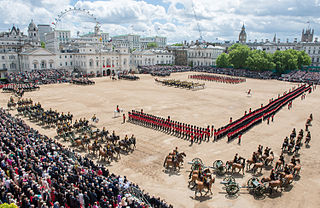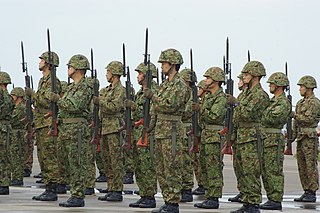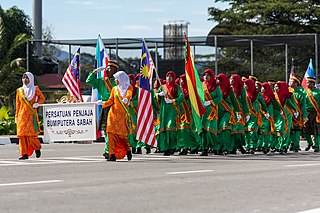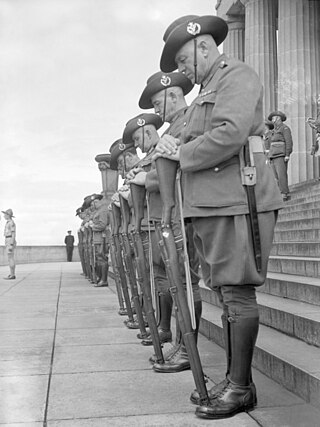
A salute is usually a formal hand gesture or other action used to display respect in military situations. Salutes are primarily associated with the military and law enforcement, but many civilian organizations, such as Girl Guides, Boy Scouts and the Salvation Army use formal salutes. Ordinary civilians also salute informally to greet or acknowledge the presence of another person, such as a tip of the hat or a hand wave to a friend or neighbour.

In military organizations, a colour guard is a detachment of soldiers assigned to the protection of regimental colours and the national flag. This duty is highly prestigious, and the military colour is generally carried by a young officer (ensign), while experienced non-commissioned officers are assigned to the protection of the national flag. These non-commissioned officers, accompanied in several countries by warrant officers, can be ceremonially armed with either sabres or rifles to protect the colour. Colour guards are generally dismounted, but there are also mounted colour guard formations as well.

Trooping the Colour is a ceremonial event performed every year on Horse Guards Parade in London, United Kingdom, by regiments of Household Division, to celebrate the official birthday of the British sovereign. It is also known as the Sovereign's Birthday Parade. Similar events are held in other countries of the Commonwealth. In the UK, it is, with the State Opening of Parliament, one of the biggest events of the ceremonial calendar, and watched by millions on TV and on the streets of London.

Marching refers to the organized, uniformed, steady walking forward in either rhythmic or route-step time; and, typically, it refers to overland movements on foot of military troops and units under field orders. Marching is often performed to march music and is typically associated with military and civilian ceremonial parades. It is a major part of military basic training in most countries and usually involves a system of drill commands.

The Ceremonial Guard is an ad hoc military unit in the Canadian Armed Forces that performs the Changing the Guard ceremony on Parliament Hill and posts sentries at Rideau Hall, with the National War Memorial being sentried by the National Sentry Program (NSP), which is carried out by different regiments and other units in order of precedence throughout the summer until mid-November.

The position of at attention, or standing at attention, is a military posture which involves the following general postures:

A manual of arms was an instruction book for handling and using weapons in formation, whether in the field or on parade. Such manuals were especially important in the matchlock and flintlock eras, when loading and firing was a complex and lengthy process typically carried out in close order. When capitalized, the term has reference to one of several important manuals, such as the British Army manual of 1764, the manual of Frederick the Great or Von Steuben's Regulations for the Order and Discipline of the Troops of the United States, adopted by the Continental Army in 1777. The positions and evolutions contained in such manuals have become the standard for parade drill throughout most of the world.

A close order formation is a military tactical formation in which soldiers are close together and regularly arranged for the tactical concentration of force. It was used by heavy infantry in ancient warfare, as the basis for shield wall and phalanx tactics, to multiply their effective weight of arms by their weight of numbers. In the Late Middle Ages, Swiss pikemen and German Landsknechts used close order formations that were similar to ancient phalanxes.

Present arms is a two-part drill command used by many militaries and public safety professionals in the world as a sign of respect. It comes from the old British command "Arms to the present!"

Military step or march is a regular, ordered and synchronized walking of military formations.

The Independence Day Parade is held every 31 August in commemoration of Malaya's independence. Since independence, the event has been usually held at the Independence Square in Kuala Lumpur, the original site of the first independence parade held on 1 September 1957.
The Thai Royal Guards parade, also known as Trooping the Colour, occurs every December 2 since 1953, in celebration of the birthday of the King of Thailand, during which the King's Guard of the Royal Thai Armed Forces perform a military parade and pledge loyalty to the monarch. The venue is the Royal Plaza at Bangkok, Thailand, in front of the Dusit Palace and its Ananta Samakhom Throne Hall.
This is a glossary of terms used in fencing.

The South African Army Training Formation is the controlling entity of all South African Army training units. The Formation was established in April 1999 and mandated to provide, maintain and sustain landward common training to the SA Army.

The Moscow Victory Day Parade refers to the annual military parade of the Russian Armed Forces on Moscow's Red Square on May 9 during the Victory Day celebrations. The most important parade of those being held on May 9 is the one held on Moscow's Red Square, with the President of Russia as the guest of honor and keynote speaker in virtue of his constitutional mandate as Supreme Commander of the Russian Armed Forces. The parade is a commemoration of the capitulation of Nazi Germany to the Red Army, marking the end of the Eastern Front of World War II, known in Russia as the Great Patriotic War.
Independence Day, also known as the Fifth of July is the national independence holiday of Venezuela, marked every year on July 5 which celebrates the anniversary since the enactment of the 1811 Venezuelan Declaration of Independence, making the country the first Spanish colony in South America to declare independence. In recent years, it is also marked as National Armed Forces Day to honor the faithful service of all the serving men and women and veterans of the National Bolivarian Armed Forces of Venezuela.
The uniforms of the Australian Army have changed significantly over the past century, although the accoutrements worn over this period have remained relatively similar. The forces of the Australian colonies and the early forces of the Commonwealth post-Federation in 1901 closely followed the uniforms of the British Army. Since then it has continued to be influenced by British but also US styles, as well as including some distinctly Australian designs, reflecting local conditions and trends.

The Presentation of Colours is a military ceremony that marks an anniversary or significant event in the history of a particular regiment or similar military unit. This involves the presentation of a new version of the regimental colour to a regiment or equivalent formation in their respective armed forces service branch. This is a traditional ceremony that was pioneered by the British Armed Forces, and is today used in most Commonwealth countries.

Reverse arms and the related rest on arms reversed are military drill commands used as a mark of respect at funerals and on occasions of mourning, especially in the armed forces of Commonwealth nations. When marching in reverse arms the soldier's weapon is held pointing behind them and grasped behind their back. When resting on reversed arms the weapon points towards the ground and the eyes are lowered.

The National Day Parade, officially the National Day of the People's Republic of China Parade, is a civil-military parade event held at Tiananmen Square in Beijing, the capital of the People's Republic of China, on the National Day of the People's Republic of China on 1 October. It is organized by the People's Liberation Army, the People's Armed Police and the Militia, as well as civilian groups of the Chinese Communist Party (CCP). It has been held every decade since 1959, annually from 1950 to 1959, and has been broadcast live on China Central Television since 1984.



















